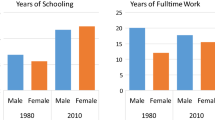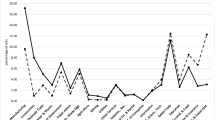Abstract
Jobs held largely by women have low pay for the amount of education they require. Why is this? One hypothesis is that employers prefer to hire men, and all workers prefer better jobs, so that women can get in only when a job's rewards (relative to its skill requirements) are low enough that men no longer want the job. Thus, wages affect sex composition. Others see the causal arrow to run the other way. In this view, the sex composition of jobs affects the wage that employers offer; employers' biased perceptions lead them to see jobs as less important and less payworthy if they are filled largely by women. These explanations are not mutually exclusive; the causal arrow may run both ways (or neither way). In this paper we use CPS data from 1984 to 1991 and a cross-lag panel model to examine these effects. Jobs are defined with a detailed occupational category within a specific broad industry category. We find that jobs with a higher percentage of females at one point have slower wage growth (or steeper wage decline) for both men and women in the ensuing years. But we find no effect of earlier wage rate on later sex composition. For those interested in reducing gender inequality in earnings, these findings suggest the utility of “comparable worth” policies.
Similar content being viewed by others
References
Allison, Paul. “Change Scores as Dependent Variables in Regression Analysis,” In Sociological Methodology. (Pp. 93–114.) Edited by C.C. Clogg. Oxford: Basil Blackwell, 1990.
Baron, James, and Andrew Newman, “Pay the Man: Effects of Demographic Composition on Prescribed Wage Rates in the California Civil Service,” In Pay Equity: Empirical Inquiries. (Pp. 107–30.) Edited by Robert Michael, Heidi Hartmann, and Brigid O'Farrell. Washington, DC: National Academy Press, 1989.
Beck, E. M., Patrick M. Horan, and Charles M. Tolbert II. “Stratification in a Dual Economy: A Sectoral Model of Earnings Determination,” American Sociological Review 43 (1978): 704–20.
Blau, Francine D. “Trends in the Well-Being of American Women, 1970–1995.” Journal of Economic Literature 36 (1998): 112–65.
Budig, Michelle J., and Paula England. “The Wage Penalty for Motherhood.” American Sociological Review 66 (2001): 204–25.
Catanzarite, Lisa. “Race-Gender Composition and Occupational Pay Degradation.” Social Problems 50 (2003): 14–37.
Coverdill, James E. “The Dual Economy and Sex Differences in Earnings.” Social Forces 66, no. 4 (1988): 970–93.
England, Paula. Comparable Worth: Theories and Evidence. Hawthorne, NY: Aldine de Gruyter, 1992.
England, Paula, Karen Christopher, and Lori R. Reid. “Gender, Race, Ethnicity, and Wages.” In Latinas and African American Women at Work. Edited by Irene Browne. New York: Russell Sage, 1999.
England, Paula, George Farkas, Barbara Stanek Kilbourne, and Thomas Dou. “Explaining Occupational Sex Segregation and Wages: Findings from a Model with Fixed Effects.” American Sociological Review 53 (1988): 544–58.
Filer, Randall. “Male-Female Wage Differences: The Importance of Compensating Differentials.” Industrial and Labor Relations Review 38, no. 3 (1985): 426–37.
Filer, Randall. “Occupational Segregation, Compensating Differentials, and Comparable Worth.” In Pay Equity. Empirical Inquiries. (Pp. 153–70.) Edited by Robert T. Michael, Heidi I. Hartmann, and Brigid O'Farrell. Washington, DC: National Academy Press, 1989.
Filer, Randall. “Compensating Differentials and the Male-Female Wage Gap: A Comment.” Social Forces 69, no. 2 (1990): 469–74.
Finkel, Steven E. Causal Analysis with Panel Data. Thousand Oaks, CA: Sage Publications, 1995.
Hodson, Randy, and Paula England. “Industrial Structure and Sex Differences in Earnings.” Industrial Relations 25, no. 1 (1986): 16–32.
Jacobs, Jerry A., and Ronnie J. Steinberg. “Compensating Differentials and the Male-Female Wage Gap: Evidence from the New York State Comparable Worth Study.” Social Forces 69, no. 2, (1990): 439–68.
Jacobs, Jerry A., and Ronnie J. Steinberg. “Compensating Differentials and the Male-Female Wage Gap: A Reply.” Social Forces 69, no. 2, (1990): 439–68.
Kilbourne, Barbara, Paula England, George Farkas, Kurt Beron, and Dorothea Weir. “Returns to Skills, Compensating Differentials, and Gender Bias: Effects of Occupational Characteristics on the Wages of White Women and Men.” American Journal of Sociology 100 (1994): 689–719.
Kmec, Julie A. “Minority Job Concentration and Wages,” Social Problems 50 (2003): 38–59.
Macpherson, David A., and Barry T. Hirsch. “Wages and Gender Composition: Why Do Women's Jobs Pay Less?” Journal of Labor Economics 13, no. 3m (1995): 426–71.
National Committee on Pay Equity. “The Wage Gap.” [online]. Available from World Wide Web [cited 1999]: http://www.feminist.com/wagegap/htm
Petersen, Trond, and Laurie A. Morgan. “Separate and Unequal: Occupation-Establishment Sex Segregation and the Gender Wage Gap.” American Journal of Sociology 101, no. 2, (1995): 329–65.
Pfeffer, Jeffrey, and Alison Davis-Blake. “The Effect of the Proportion of Women on Salaries: The Case of College Administrators.” Administrative Science Quarterly 32 (1987): 1–24.
Reskin, Barbara F., and Patricia Roos. Job Queues, Gender Queues: Explaining Women's Inroads into Male Occupations. Philadelphia: Temple University Press, 1990.
Snyder, David, and Paula M. Hudis. “Occupational Income and the Effects of Minority Competition and Segregation: A Reanalysis and Some New Evidence.” American Sociological Review 41 (1976): 209–34.
Sorensen, Elaine. Comparable Worth: Is It a Worthy Policy? Princeton, NJ: Princeton University Press, 1994.
Steinberg, R. J. “Comparable Worth in Gender Studies.” In International Encyclopedia of the Social & Behavioral Sciences, edited by Neil J. Smelser and Paul B. Baltes. Oxford: Cambridge University Press, Vol. 4 (2001): 2393–97.
Strober, Myra H. “Toward a General Theory of Occupational Sex Segregation: The Case of Public School Teaching.” In Sex Segregation in the Workplace: Trends, Explanations, Remedies. (Pp. 144–56). Edited by Barbara F. Reskin. Washington, DC: National Academy Press, 1984.
Strober, Myra H., and Carolyn L. Arnold, “The Dynamics of Occupational Segregation Among Bank Tellers.” In Gender in the Workplace. (Pp. 107–48.) Edited by Clair Brown and Joseph A. Pechman. Washington, DC: Brookings Institution, 1987.
Strober, Myra H., and Lisa M. Catanzarite. “The Relative Attractiveness Theory of Occupational Segregation by Gender.” In Women's Employment, Special Issue of Beiträge zur Arbeitsmarkt- und Berufsforschung. (Translation from German: Labor Market and Occupational Research.) 179 (1994): 116–139.
Tomaskovic-Devey, Donald. Gender and Racial Inequality at Work: the Sources and Consequences of Job Segregation. Ithaca, NY: ILR Press, 1993.
U.S. Department of Commerce, Bureau of the Census. Current Population Survey: Annual Demographic File, 1983–1991 [Computer file] Washington, DC: U.S. Department of Commerce, Bureau of the Census.
Wellington, Allison J. “Changes in the Male-Female Wage Gap, 1976–1985.” Journal of Human Resources 28 (1993): 383–411.
Wellington, Allison J. “Accounting for the Male/Female Wage Gap Among Whites: 1976 and 1985.” American Sociological Review 59 (1994): 839–84.
Wright, Rosemary and Jerry A. Jacobs. “Male Flight from Computer Work: A New Look at Occupational Resegregation and Ghettoization.” American Sociological Review 59 (1994): 511–36.
Author information
Authors and Affiliations
Corresponding author
Additional information
Carolyn J. Aman Karlin earned her Ph.D. in sociology at the University of Arizona and taught at the University of Central Arkansas. Now pursuing a second career, she is studying veterinary medicine at the University of Minnesota.
Paula England is a professor of sociology at Northwestern University and affiliated with the Institute for Policy Research. Her teaching and research focus on gender in the labor marker and family, and on integrating sociological, economic, and feminist theories.
Mary Richardson earned her M.A. in sociology at Northwestern University, emphasizing economic sociology and gender issues. She now works as a senior financial analyst at Newark InOne in Chicago.
Rights and permissions
About this article
Cite this article
Karlin, C.A., England, P. & Richardson, M. Why do “Women’s jobs” have low pay for their educational level?. Gend. Issues 20, 3–22 (2002). https://doi.org/10.1007/s12147-002-0020-6
Issue Date:
DOI: https://doi.org/10.1007/s12147-002-0020-6




